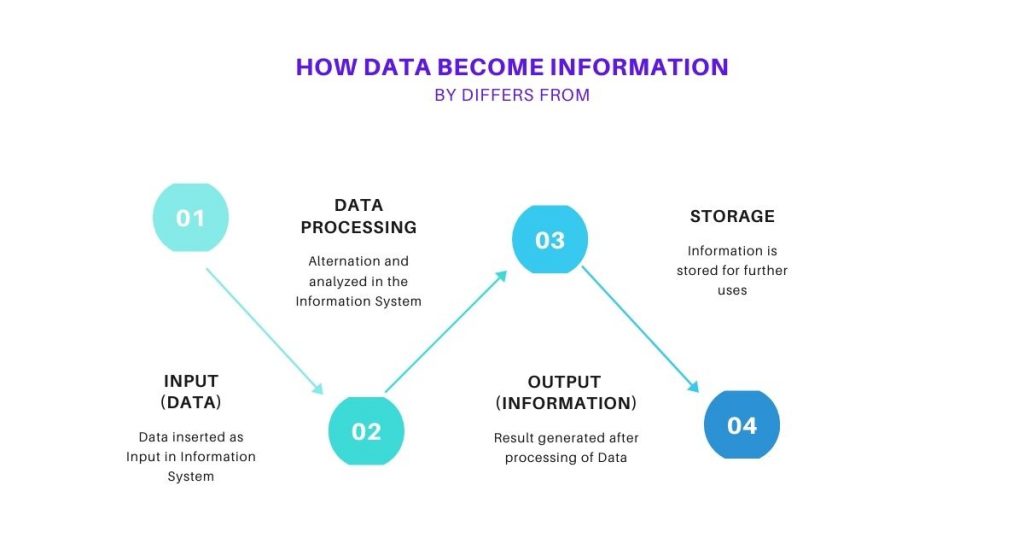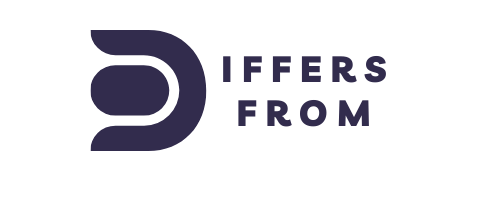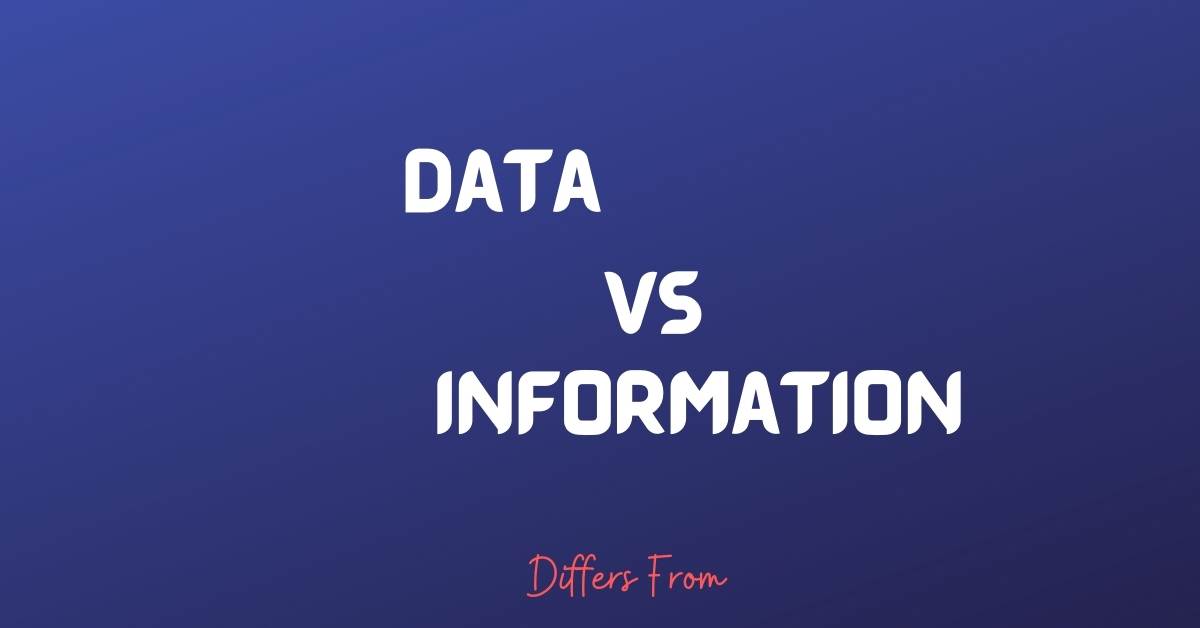Data and Information, we hear about these words so much, right? But do we know the difference between information and data? In this article, we share some differences between data and information from different angles. Let’s differs from!
Defination of Data:
In simple words, data can be defined as facts and figures that we collected together for analysis or reference. We collect data using standard procedures such as in-person interviews, phone calls, surveys, and observations and stored it for analysis or evaluation. Data has no significance stand alone and does not carry any specific purpose.
Examples of data:
2564125, Website Traffic, Transaction time
What is Information?
Again, in simple words, information is processed, organized, and structured data. We use the information in significant ways. A researcher can evaluate their hypothesis on the basis of collected data. A businessman analyzes, organizes the collected data, and makes business decisions.
Example of Information
- (123) 456 789 as a phone number
- Knowing most of the traffic is organic traffic
- Determining the time of day, you process most transactions
Main Difference between Information and Data
| Parameters | Data | Information |
| Description | Unorganized and raw variables help to develop ideas and information. | When Data is structured and carries contextual meaning, it’s called information. |
| Etymology | “Data” comes from a singular Latin word, datum, which means “something given.” | Information comes from both French and Middle English; it is always referred to as the “act of informing”. |
| Format | Data can be both qualitative or quantitative. It is in the form of numbers or letters. | Information is the Ideas and inferences |
| Features | Data is available in the form of raw units that need to be organized. so it does not carry any meaning by itself. | Information is a result of processed data; it may depict an idea or meaning |
| Significance | Stand alone, data have no significance. | Information is significant as it has some context and provides some meaning. |
| Represented in | It can be presented in tabular data, graphs, data trees, etc. | Information is seen as Language, ideas, and thoughts that are based on the given data. |
| Meaning | Data does not have any specific purpose. | Information has a meaning which is derived from processing data. |
| Dependence | Data is independent. | It depended on Data. |
| Measuring unit | Measured in bits and bytes. | Measured in meaningful units like time, quantity, etc. |
| Support for Decision making | We cannot make a decision based on the data | Meaningful data, i e Information can be used to make decisions. |
| Knowledge level | It is low-level knowledge. | It is the second level of knowledge. |
| Example | Ticket sales on a band on tour. | Sales report by region and venue. It gives information on which venue is profitable for that business. |
| Origin | Data is based on observations and records. | The source of information is data. |
| Analysis | Data is never analyzed in its initial form | The information is always analyzed, in other words, when data is analyzed, it becomes information |
| Usefulness | Data is not always useful as it is needed to be processed | Information is always useful as it provides some meaning |
| Volume | Data is normally huge in volume | Information is normally short in volume |
| Sale Value | Data can be an asset for the organization and not available for sale | It is also an asset for an organization but is available for sale. |
Data vs Information in Infographinc

What are Key differences between Data and Information?
- Data is a collection of facts. Information is the contextual meaning of these facts.
- Data is unorganized, while information can be called arranged or organized data.
- Information is an uncountable noun, while data is a mass noun.
- Data always used with a plural verb while information is used with a singular verb.
- Data has not any significance in its own, but information has.
- Data is independent and Information depends on data.
Difference between information and data in Computer
In the world of computers, data and information are different from what we learned above. Data is the input for computers. It is a set of characters, symbols, and numbers by which we tell the computer what to do. On the contrary, Information is the output. The computer analyzes the data that we imputed and shows us the requested actions. It has more contextual value.
So, anything that is considered as input for a data processing system like a computer or other software, is data that is further processed and stored as information and meaning to the data.
How does Data become Information?

Frequently Asked Question
1. What are the examples of data and information?
Data is a raw, unanalyzed, unorganized and unrelated entity that doesn’t have any contextual meaning. And information is the processed data that is converted to provide meaning.
For example, we take some data in below:
$23,000, $31,000 and $ 37,000
It describes nothing. It does not have any contextual meaning. We do not know the cost of production, the salary of some employees or the rent of the house, it could be anything. It does not provide any information or knowledge.
Now, look at these numbers
Sales of Computer House Inc.
January $23,000
February $31,000
March $ 37,000
Do these data make any sense to you? Yes, this is some information about the monthly sales of Computer House Inc. and their sales are increasing every month.
2. Which is more useful data or information?
Information is useful for business or other decision-making processes, but information can not be produced without analyzing data. So, we can’t provide any strong statement about which one is the most important.
3. What are the characteristics of information?
- Availability/accessibility
- Accuracy
- Reliability or objectivity
- Completeness
- Level of detail/conciseness
- Presentation
- Timing
- Value of information
4. What is the importance of information?
- The information helps policymakers and decision-makers to make decisions.
- The information helps the human to enrich their knowledge.
- Information generates another new information.
- In today’s hypercompetitive business world, information is as important as capital for business, whether it is about inventory, pricing, or cost.
- Information also helps business to develop advertisement to reach more audience.
5. What are the three sources of Information?
Information can be sourced in three ways, these are
- Primary sources: Interviews, Artwork, Speeches, etc.
- Secondary source: Bibliographic, Histories, etc.
- Tertiary Source: Handbooks, Dictionaries, etc.
6. Why do we collect data? Why Data Collection is important?
Data collection is the organized approach to accumulating facts from a variety of sources to get a complete and accurate picture of a particular area. Data collection enables a person or organization to answer pertinent questions, analyze situations, evaluate outcomes and make forecasts about future probabilities and trends.
Importance of data collection:
- Organized data allows the organization to make informed decisions
- Data helps to identify problems
- Data allows you to develop precise concepts or ideas
- Data makes your tactic strategic
- Data increases your ROA

